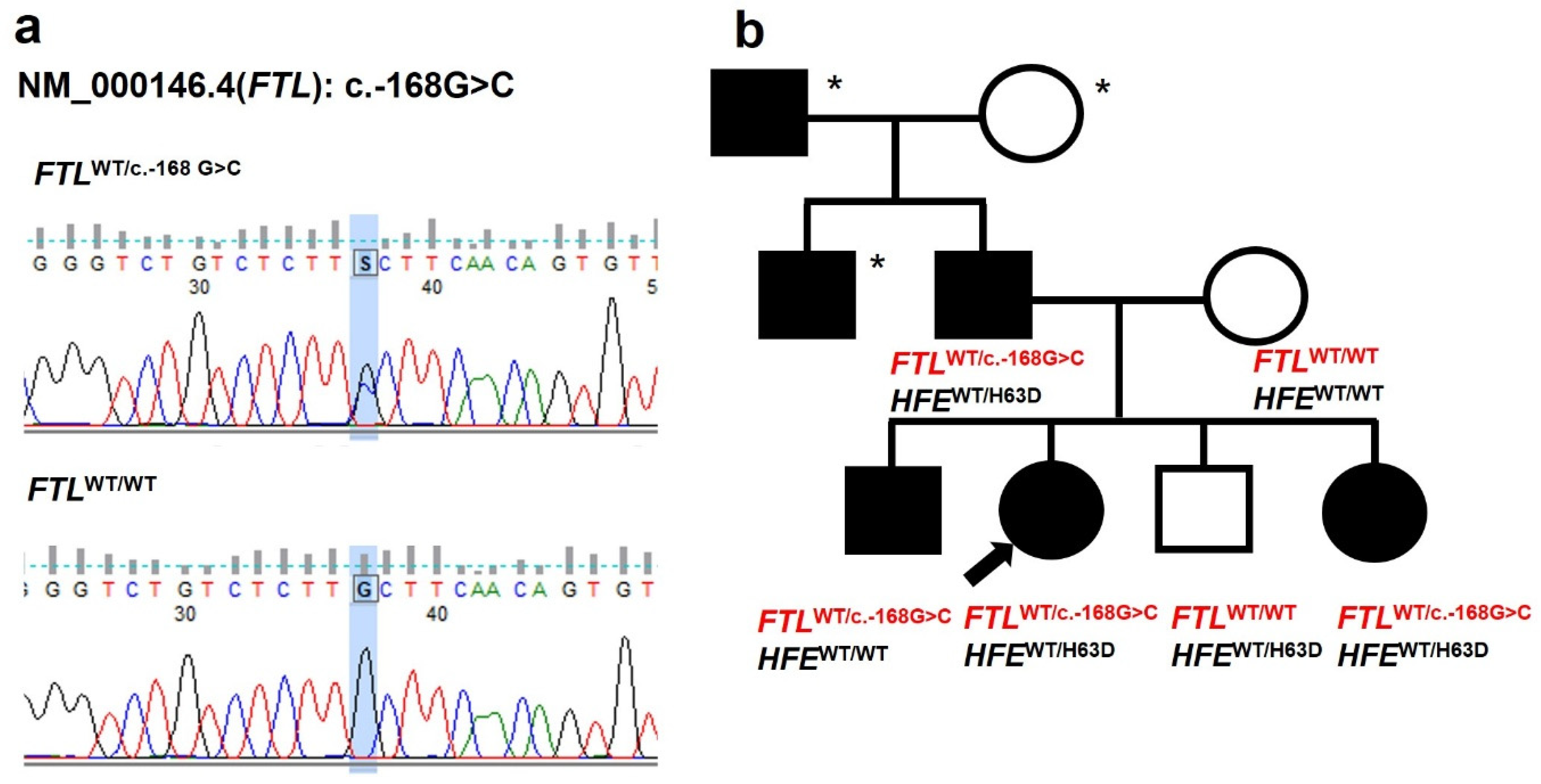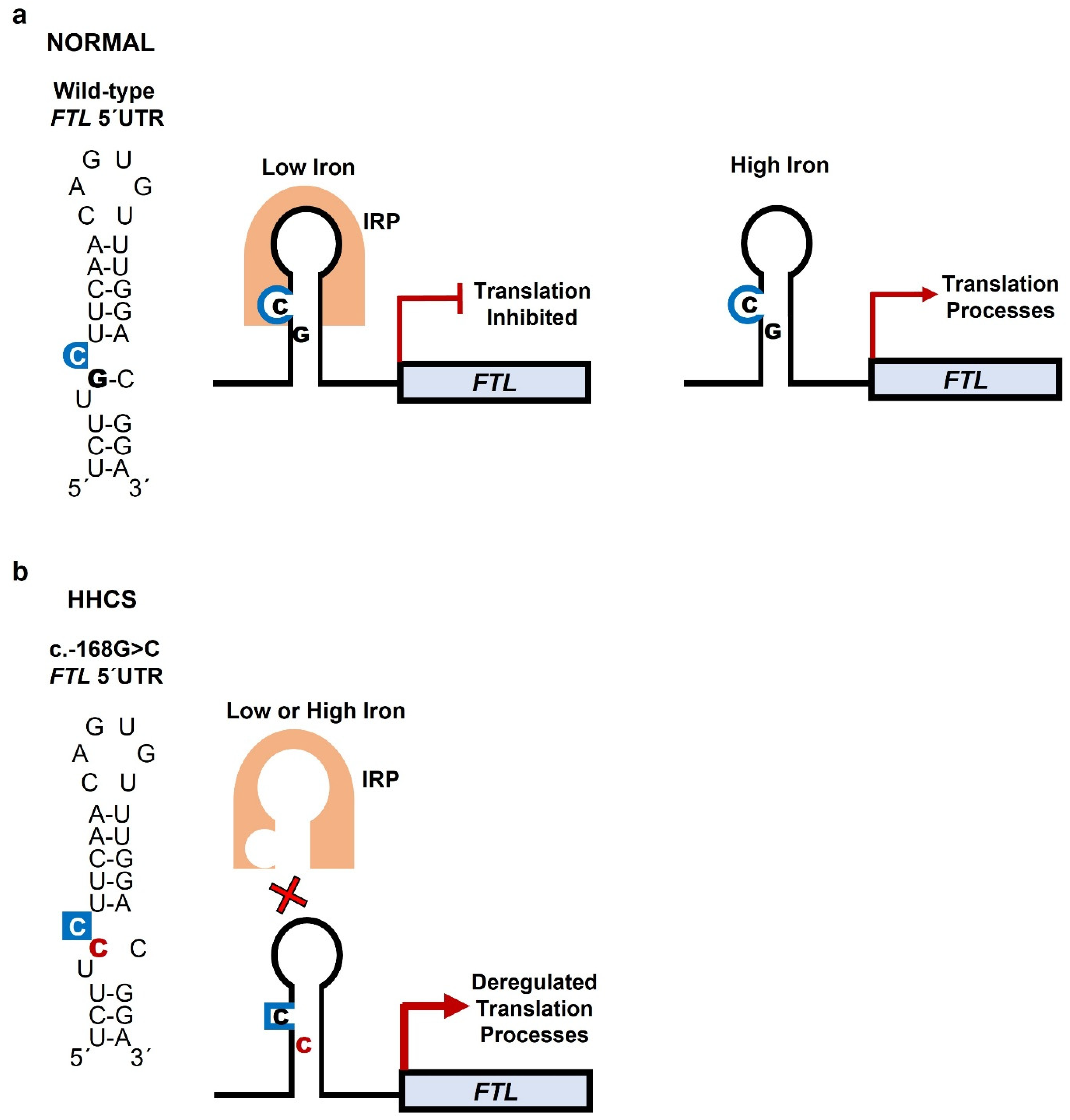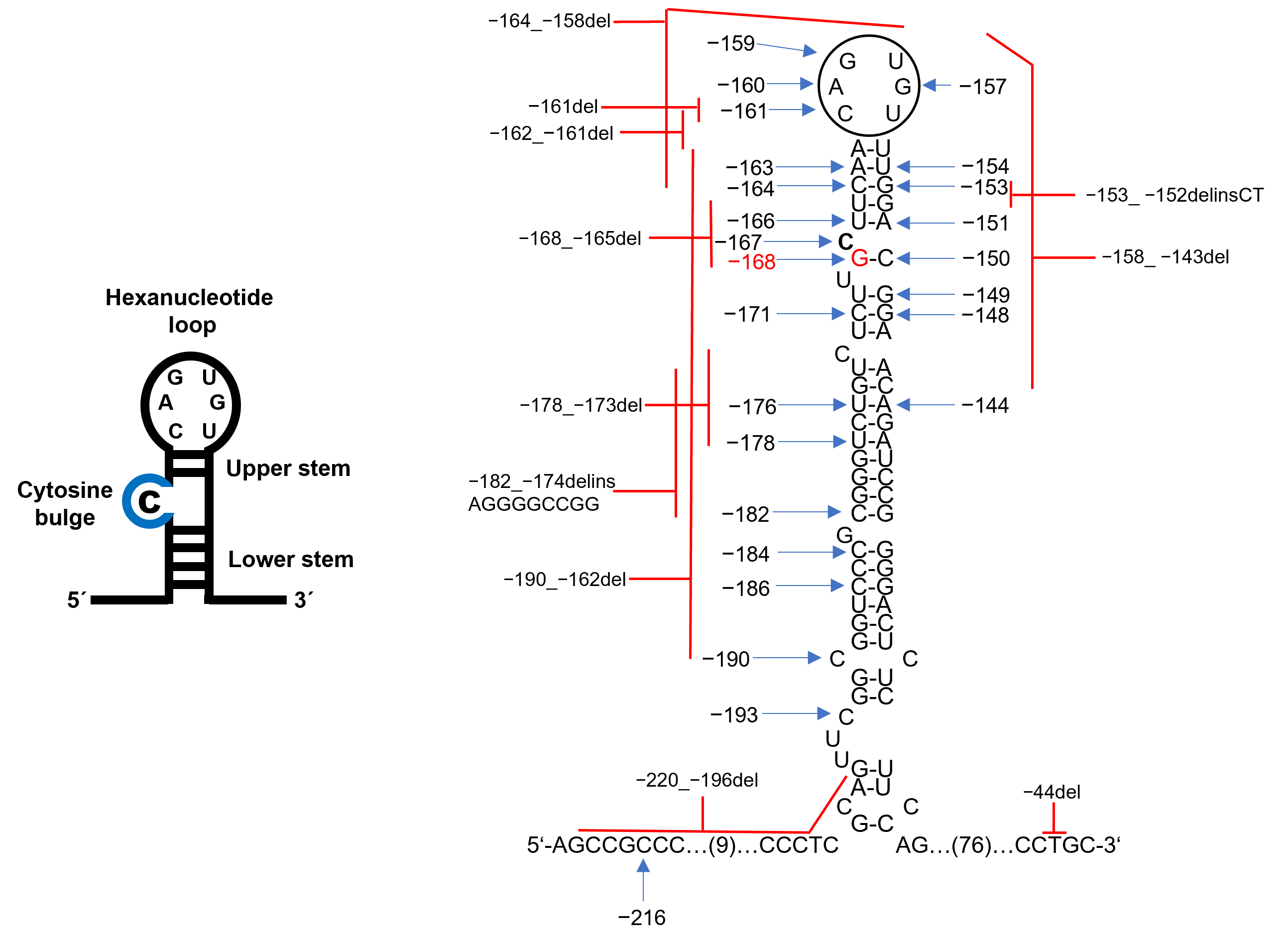Clinical and Molecular Clues to Diagnosing Hereditary Hyperferritinemia-Cataract Syndrome: Case Report and Literature Review
Abstract
1. Introduction
2. Materials and Methods
2.1. Clinical and Biochemical Analyses
2.2. Targeted Sanger Sequencing
2.3. Literature Review Methodology
3. Results
3.1. Clinical Findings and Biochemical Analyses
3.2. Genetic Testing
3.3. HFE Genotyping and Hepcidin Measurement
4. Discussion
5. Conclusions
Author Contributions
Funding
Institutional Review Board Statement
Informed Consent Statement
Data Availability Statement
Acknowledgments
Conflicts of Interest
Abbreviations
| 5′ UTR | 5′ untranslated region |
| FTL | ferritin light chain gene |
| HAMP | hepcidin antimicrobial peptide |
| HFE | homeostatic iron regulator |
| HH | hereditary hemochromatosis |
| HHCS | hereditary hyperferritinemia-cataract syndrome |
| HJV | hemojuvelin |
| IRE | iron-responsive element |
| IRPs | iron regulatory proteins |
| MRI | magnetic resonance imaging |
| TFR2 | transferrin receptor 2 |
References
- Girelli, D.; Ouvieri, O.; De Franceschi, L.; Corrocher, R.; Bergamaschi, G.; Cazzola, M. A linkage between hereditary hyperferritinaemia not related to iron overload and autosomal dominant congenital cataract. Clinical, biochemical and molecular findings in a family with hereditary hyperferritinaemia cataract syndrome. Br. J. Haematol. 1995, 90, 931–934. [Google Scholar] [CrossRef]
- Luscieti, S.; Tolle, G.; Aranda, J.; Campos, C.B.; Risse, F.; Morán, É.; Muckenthaler, M.U.; Sánchez, M. Novel mutations in the ferritin-L iron-responsive element that only mildly impair IRP binding cause hereditary hyperferritinaemia cataract syndrome. Orphanet J. Rare Dis. 2013, 8, 30. [Google Scholar] [CrossRef]
- Cazzola, M.; Bergamaschi, G.; Tonon, L.; Arbustini, E.; Grasso, M.; Vercesi, E.; Barosi, G.; Bianchi, P.E.; Cairo, G.; Arosio, P. Hereditary hyperferritinemia-cataract syndrome: Relationship between phenotypes and specific mutations in the iron-responsive element of ferritin light-chain mRNA. Blood 1997, 90, 814–821. [Google Scholar] [CrossRef]
- Hentze, M.W.; Kühn, L.C. Molecular control of vertebrate iron metabolism: mRNA-based regulatory circuits operated by iron, nitric oxide, and oxidative stress. Proc. Natl. Acad. Sci. USA 1996, 93, 8175–8182. [Google Scholar] [CrossRef]
- Girelli, D.; Bozzini, C.; Zecchina, G.; Tinazzi, E.; Bosio, S.; Piperno, A.; Ramenghi, U.; Peters, J.; Levi, S.; Camaschella, C.; et al. Clinical, biochemical and molecular findings in a series of families with hereditary hyperferritinaemia-cataract syndrome. Br. J. Haematol. 2001, 115, 334–340. [Google Scholar] [CrossRef]
- Camaschella, C.; Poggiali, E. Towards explaining “unexplained hyperferritinemia”. Haematologica 2009, 94, 307–309. [Google Scholar] [CrossRef]
- Cazzola, M. Hereditary hyperferritinaemia/ cataract syndrome. Best. Pract. Res. Clin. Haematol. 2002, 15, 385–398. [Google Scholar] [CrossRef]
- Sochorcova, L.; Hlusickova Kapralova, K.; Fialova Kucerova, J.; Pospisilova, D.; Prochazkova, D.; Jahoda, O.; Kurekova, S.; Kralova, B.; Divoka, M.; Navratilova, J.; et al. Elevated erythroferrone distinguishes erythrocytosis with inherited defects in oxygen-sensing pathway from primary familial and congenital polycythaemia. Br. J. Haematol. 2023, 202, 674–685. [Google Scholar] [CrossRef] [PubMed]
- Martin, M.E.; Fargion, S.; Brissot, P.; Pellat, B.; Beaumont, C. A point mutation in the bulge of the iron-responsive element of the L ferritin gene in two families with the hereditary hyperferritinemia-cataract syndrome. Blood 1998, 91, 319–323. [Google Scholar] [CrossRef] [PubMed]
- Moravikova, J.; Honzik, T.; Jadvidzakova, E.; Zdrahalova, K.; Kremlikova Pourova, R.; Korbasova, M.; Liskova, P.; Dudakova, L. Hereditary hyperferritinemia-cataract syndrome in three Czech families: Molecular genetic testing and clinical implications. J. AAPOS 2020, 24, e1–e352.e5. [Google Scholar] [CrossRef] [PubMed]
- Mattila, R.M.; Sainio, A.; Järveläinen, M.; Pursiheimo, J.; Järveläinen, H. A novel double nucleotide variant in the ferritin-L iron-responsive element in a Finnish patient with hereditary hyperferritinaemia-cataract syndrome. Acta Ophthalmol. 2018, 96, 95–99. [Google Scholar] [CrossRef] [PubMed]
- Pietrangelo, A. Hereditary hemochromatosis: Pathogenesis, diagnosis, and treatment. Gastroenterology 2010, 139, 393–408.e2. [Google Scholar] [CrossRef]
- Lim, D.R.; Vidyasankar, G.; Phua, C.; Borgaonkar, M. Clinical Penetrance of Hereditary Hemochromatosis-Related End-Organ Damage of C282Y Homozygosity, A Newfoundland Experience. Clin. Transl. Gastroenterol. 2020, 11, e00258. [Google Scholar] [CrossRef] [PubMed]
- Ganz, T.; Nemeth, E. Hepcidin and disorders of iron metabolism. Annu. Rev. Med. 2011, 62, 347–360. [Google Scholar] [CrossRef]
- Celma Nos, F.; Hernández, G.; Ferrer-Cortès, X.; Hernandez-Rodriguez, I.; Navarro-Almenzar, B.; Fuster, J.L.; Bermúdez Cortés, M.; Pérez-Montero, S.; Tornador, C.; Sanchez, M. Hereditary Hyperferritinemia Cataract Syndrome: Ferritin L Gene and Physiopathology behind the Disease-Report of New Cases. Int. J. Mol. Sci. 2021, 22, 5451. [Google Scholar] [CrossRef] [PubMed]
- Yang, Y.; Lin, T.; Kuang, P.; Chen, X. Ferritin L-subunit gene mutation and hereditary hyperferritinaemia cataract syndrome (HHCS): A case report and literature review. Hematology 2021, 26, 896–903. [Google Scholar] [CrossRef]
- Giansily-Blaizot, M.; Cunat, S.; Moulis, G.; Schved, J.F.; Aguilar-Martinez, P. Homozygous mutation of the 5′UTR region of the L-Ferritin gene in the hereditary hyperferritinemia cataract syndrome and its impact on the phenotype. Haematologica 2013, 98, 42–43. [Google Scholar] [CrossRef]
- Van de Sompele, S.; Pecheux, L.; Couso, J.; Meunier, A.; Sanchez, M.; De Baere, E. Functional characterization of a novel non-coding mutation “Ghent +49A>G” in the iron-responsive element of L-ferritin causing hereditary hyperferritinaemia-cataract syndrome. Sci. Rep. 2017, 7, 18025. [Google Scholar] [CrossRef]
- Neofytou, A.; Damianaki, A.; Kossiva, L. A rare case report of hereditary hyperferritinemia cataract syndrome. Pediatr. Hematol. Oncol. J. 2025, 10, 17–19. [Google Scholar] [CrossRef]
- Arosio, C.; Fossati, L.; Viganò, M.; Trombini, P.; Cazzaniga, G.; Piperno, A. Hereditary hyperferritinemia cataract syndrome: A de novo mutation in the iron responsive element of the L-ferritin gene. Haematologica 1999, 84, 560–561. [Google Scholar]
- Craig, J.E.; Clark, J.B.; McLeod, J.L.; Kirkland, M.A.; Grant, G.; Elder, J.E.; Toohey, M.G.; Kowal, L.; Savoia, H.F.; Chen, C.; et al. Hereditary hyperferritinemia-cataract syndrome: Prevalence, lens morphology, spectrum of mutations, and clinical presentations. Arch. Ophthalmol. 2003, 121, 1753–1761. [Google Scholar] [CrossRef] [PubMed]
- Christiansen, G.; Mohney, B.G. Hereditary hyperferritinemia-cataract syndrome. J. AAPOS 2007, 11, 294–296. [Google Scholar] [CrossRef]
- Shiels, A.; Hejtmancik, J.F. Inherited cataracts: Genetic mechanisms and pathways new and old. Exp. Eye Res. 2021, 209, 108662. [Google Scholar] [CrossRef]
- Ang, M.J.; Afshari, N.A. Cataract and systemic disease: A review. Clin. Exp. Ophthalmol. 2021, 49, 118–127. [Google Scholar] [CrossRef] [PubMed]
- Eris, T.; Yanik, A.M.; Demirtas, D.; Yilmaz, A.F.; Toptas, T. Hereditary Hyperferritinemia-Cataract Syndrome in a Family With HFE-H63D Mutation. Cureus 2023, 15, e36253. [Google Scholar] [CrossRef] [PubMed]



| Proband | Sister | 1st Brother | Father | Mother | 2nd Brother | |
|---|---|---|---|---|---|---|
| Age [years] | 13 | 6 | 18 | 51 | 46 | 8 |
| Sex | F | F | M | M | F | M |
| FTL mutation | c.-168G>C/wt | c.-168G>C/wt | c.-168G>C/wt | c.-168G>C/wt | wt | wt |
| HFE mutation | H63D/wt | H63D/wt | wt | H63D/wt | wt | H63D/wt |
| Ferritin [ng/mL] (ref. values: 10–322 #) | 1418 ± 265 | 1333 | 1202 | 1847 | - | - |
| sFe [uM/L] (ref. values: 10.6–28.3) | 18.2 | 23.1 | 12.5 | 25.6 | - | - |
| TIBC [μM/L] (ref. values: 44.8–76.1) | 73.8 | 67.4 | 70.7 | 64.0 | - | - |
| TSAT [%] (ref. values: 20–50) | 24.7 | 34.3 | 17.7 | 40 | . | - |
| Hepcidin [ng/mL] (ref. values: 5.92 ± 3.75 *) | 1.98 | 2.61 | 0.45 | 10.60 | 2.01 | 0.87 |
| Age of cataract dg. | Newborn | Newborn | Newborn | Early childhood | - | - |
| Age of cataract surgery [years] | 12 | - | - | 19 | - | - |
| Remark/status | - | Occlusion therapy ongoing | Awaiting surgery | - | - |
| Mutation | Alternate/Old Names | Structural/Functional Notes |
|---|---|---|
| Point Mutations | ||
| c.-110C>T | +90C>U | Downstream IRE. |
| c.-144A>T | Paris + 56A>U | Lower stem; alters stem base pairing, impacts hairpin conformation and/or stability. |
| c.-148G>C | Heidelberg + 52G>C | |
| c.-149G>C | Torino + 51G>C | |
| c.-150C>A | +50C>A | Lower stem; affects C bulge geometry. |
| c.-151A>G, C | Ghent + 49A>G; + 49A>C | Upper stem; alters critical stem region for IRP binding. |
| c.-153G>A | Paris + 47G>A | |
| c.-154T>G | +46U>G | |
| c.-157G>A | Salt Lake City + 43G>A | Hexanucleotide loop; disrupts IRP binding. |
| c.-159G>C | Verona-1 + 41G>C | |
| c.-160A>G | Paris-1 or Montpellier-1 + 40A>G | |
| c.-161C>T, G, A | London-1 + 39C>U; Paris + 39C>G; Geelong + 39C>A | |
| c.-163A>T, G, C | Zaragoza + 37A>U; Milano + 37A>G; Pavia + 37A>C | Upper stem; alters critical stem region. |
| c.-164C>T, G, A | Badalona + 36C>U; Milano + 36C>G; London-2 + 36C>A | |
| c.-166T>C | Paris + 34U>C | Upper stem; affects hairpin stability. |
| c.-167C>T, A | Madrid or Philadelphia + 33C>U; Paris + 33C>A | C bulge; disrupts IRP binding. |
| c.-168G>T, C, A | Paris-2 or Milano-1 + 32G>U; Baltimore-1 + 32G>C; Pavia-1 + 32G>A | Lower stem; affects C bulge geometry. |
| c.-171C>G | Torino + 29C>G | Lower stem; alters stem base pairing; impacts hairpin conformation and/or stability. |
| c.-176T>C | +24U>C | |
| c.-178T>G | 22U>G | |
| c.-182C>T | Paiva-2 + 18C>U | |
| c.-184C>T | +16C>U | |
| c.-186C>G | +14C>G | |
| c.-190C>T | +10C>U | Lower stem; affects stem stability. |
| c.-193C>G | +7C>G | Lower stem near loop base; potential IRP interaction effect. |
| c.-216C>A | NA | FTL promoter. |
| Deletions | ||
| c.-44del | +176delT | 3′ flanking region; affects stability. |
| c.-153_-152delinsCT * | Pori + 47 G>C and + 48 G>T * | Upper stem; partial elimination; alters stem integrity. |
| c.-158_-143del | +42_57del16 | Hexanucleotide loop; partial elimination, disrupts IRP binding. |
| c.-162_-161del | +38_39delAC | |
| c.-161del | +39delC | |
| c.-164_-158del | Esplugues + 36_42del7 | |
| c.-168_-165del | +32_35del4 | C bulge; elimination; disrupts IRP binding. |
| c.-178_-173del | +22_27del6 | Lower stem, partial elimination, impacts IRP binding. |
| c.-182_-174delinsAGGGGCCGG | +18_ + 26del9ins9 | Complex deletion-insertion; disrupts IRE structure and IRP binding. |
| c.-190_-162del | Verona-2 + 10_38del29 | Large deletion spanning stem; eliminates IRE. |
| c.-220_-196del | NA | Large deletion; new transcription start point. |
| Mutation | Inheritance | Ferritin Range * µg/L | sFe Range * µmol/L | TSAT Range * % | Age at dg. | Ophthalmological Findings | Clinical Notes | |
|---|---|---|---|---|---|---|---|---|
| Family 1 | c.-167C>T | de novo | 750–1275 $ | 8.7 | 15.7 | P1: 7.5 y | insignificant visual lens opacities | dg. after chelation therapy and seizure due to hyperammonemia |
| Family 2 | c.-168G>C | AD | 1861–2328 | 14.6–24.3 | 20–28 | P2: 43 y | premature cataract formation | co-inheritance with HFE, hyperferritinemia incidentally found during the management of pulmonary embolism |
| P3: 4.5 y | bilateral lens opacities | hyperferritinemia noted during an investigation of petechiae formation | ||||||
| Family 3 | c.-161C>T | AD | 924–1000 | 13.8–20.1 | 31 # | P4: 36 y | premature cataract formation | - |
| P5: 3.5 y | - | hyperferritinemia found during management of joint pain and high temperature episodes |
| Feature | HHCS-Associated Cataract | Congenital Cataract | Metabolic/Secondary Cataract |
|---|---|---|---|
| Onset | Early (childhood to adolescence) | Birth or early infancy | Variable; often pediatric or young adult |
| Family history | Often familial | Often familial | Varies (depends on systemic disease) |
| Laterality | Bilateral and symmetric | Often bilateral | Bilateral or unilateral |
| Cataract morphology | Crystalline opacities in the lens cortex; frosted glass appearance | Varied: nuclear, lamellar, posterior | e.g., Snowflake (diabetes), sunflower (Wilson’s) |
| Progression | Slowly progressive | May remain stable or progress | Variable; depends on cause |
| Systemic associations | ↑ serum ferritin without iron overload | Genetic syndromes (e.g., Wolfram, Senger’s, Nance-Horan, or Down syndrome) | Diabetes, Wilson’s disease, myotonic dystrophy |
| Iron parameters | ↑ ferritin, other parameters normal | Normal | Normal or variable (e.g., high in inflammation) |
| Inheritance | AD; FTL gene | AD, AR, or X-linked: lens development genes; trisomy 21 | Depends on disease |
| Phlebotomy/ Chelation therapy | No benefit, potentially harmful; iron overload not present | Not applicable | Depends on condition (e.g., copper chelation in Wilson’s disease) |
| Other ocular findings | Non specific | May have microphthalmia, microcornea, or other signs | Depends on condition |
| Feature | HHCS | Adult HH | Juvenile HH |
|---|---|---|---|
| Gene | FTL (5′UTR) | HFE, TFR2 | HJV, HAMP |
| Inheritance | AD | AR | AR |
| Typical onset | Childhood/adolescence | 30–50 y | Childhood/adolescence |
| Serum ferritin | ↑ | ↑ | ↑↑ |
| Serum iron/TSAT | Normal | ↑ | ↑↑ |
| Hepcidin | Normal | Low-normal | Very low |
| Iron overload | No | Yes | Severe |
| Lens changes | Bilateral cataracts (early-onset) | Rare | Possible (secondary) |
| Main complications | Visual impairment | Organ iron deposition, cirrhosis, diabetes, arthropathy | Organ iron deposition, cirrhosis, cardiomyopathy, diabetes, hypogonadism |
| Management | Ophthalmologic monitoring, cataract surgery; Avoid phlebotomy/chelation | Phlebotomy | Phlebotomy ± chelation |
Disclaimer/Publisher’s Note: The statements, opinions and data contained in all publications are solely those of the individual author(s) and contributor(s) and not of MDPI and/or the editor(s). MDPI and/or the editor(s) disclaim responsibility for any injury to people or property resulting from any ideas, methods, instructions or products referred to in the content. |
© 2025 by the authors. Licensee MDPI, Basel, Switzerland. This article is an open access article distributed under the terms and conditions of the Creative Commons Attribution (CC BY) license (https://creativecommons.org/licenses/by/4.0/).
Share and Cite
Ludikova, B.; Sochorcova, L.; Jaksic, D.; Hlusickova Kapralova, K.; Horvathova, M. Clinical and Molecular Clues to Diagnosing Hereditary Hyperferritinemia-Cataract Syndrome: Case Report and Literature Review. Genes 2025, 16, 1381. https://doi.org/10.3390/genes16111381
Ludikova B, Sochorcova L, Jaksic D, Hlusickova Kapralova K, Horvathova M. Clinical and Molecular Clues to Diagnosing Hereditary Hyperferritinemia-Cataract Syndrome: Case Report and Literature Review. Genes. 2025; 16(11):1381. https://doi.org/10.3390/genes16111381
Chicago/Turabian StyleLudikova, Barbora, Lucie Sochorcova, Damjan Jaksic, Katarina Hlusickova Kapralova, and Monika Horvathova. 2025. "Clinical and Molecular Clues to Diagnosing Hereditary Hyperferritinemia-Cataract Syndrome: Case Report and Literature Review" Genes 16, no. 11: 1381. https://doi.org/10.3390/genes16111381
APA StyleLudikova, B., Sochorcova, L., Jaksic, D., Hlusickova Kapralova, K., & Horvathova, M. (2025). Clinical and Molecular Clues to Diagnosing Hereditary Hyperferritinemia-Cataract Syndrome: Case Report and Literature Review. Genes, 16(11), 1381. https://doi.org/10.3390/genes16111381






